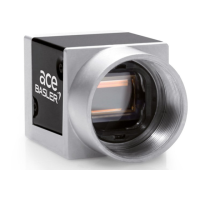AW00097603000 Camera Functional Description
Basler aviator GigE 27
4.1.2 One Sensor Tap Digitization Mode
With one tap sensor digitization, only one electronic circuit is used to read out the pixels in the
sensor (see Figure 8 on page 28). The advantage of the one tap digitization scheme is that it
eliminates the need to balance four different readout circuits as is required with four tap readout.
The drawback with one tap readout is that since it takes much longer to read out the sensor when
using one tap, the camera’s maximum achieveable frame rate is limited.
After a image has been captured (i.e., exposure has ended), the pixels in the sensor become ready
to be read out. At the start of readout, the charges accumulated during exposure are transported
from the pixels to the sensor’s vertical shift registers. The charges from the top line of pixels in the
array are then moved to the upper horizontal shift register as shown in Figure 8.
Next, the charges are moved out of the upper horizontal shift register. As the charges move out of
the horizontal shift register, they are converted to voltages proportional to the size of each charge.
Each voltage is then amplified by a Variable Gain Control (VGC) and digitized by an analog-to-
digital converter (ADC). For optimal digitization, gain and black level can be adjusted by setting
camera parameters.
After each voltage has been amplified and digitized, it passes through an FPGA and into an image
buffer. All shifting of charges from the vertical to the horizontal register and out of the horizontal
register is clocked according to the camera’s internal data rate. Shifting continues in a line-by-line
fashion until all image data has been read out of the sensor.
The pixel data leaves the image buffer and passes back through the FPGA to an Ethernet controller
where it is assembled into data packets. The packets are then transmitted via an Ethernet network
to a network adapter in the host PC. The Ethernet controller also handles transmission and receipt
of control data such as changes to the camera’s parameters.
The image buffer between the sensor and the Ethernet controller allows data to be read out of the
sensor at a rate that is independent of the data transmission rate between the camera and the host
computer. This ensures that the data transmission rate has no influence on image quality.
